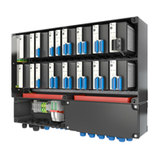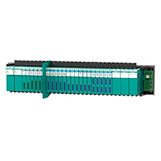
Modular remote I/O systems transmit process data from safe or explosion hazardous areas by connecting binary and analog sensors and actors to the control system via a bus interface.
You can connect 4 mA … 20 mA devices to remote I/O, including water flow transmitters, valve positioners, pressure transducers, or temperature transmitters. Devices such as thermocouples, resistance temperature detectors (RTDs), mechanical contacts, and visual or audible alarms may also be connected. Our remote I/O systems are compatible with network protocols like PROFIBUS DP, MODBUS RTU, MODBUS TCP/IP and FOUNDATION fieldbus.
Remote I/O is ideal for use where your application is located in explosion hazardous areas or harsh industrial environments like marine and outdoors. Typical applications include oil and gas (onshore and offshore), pharmaceutical, chemical, waste water, food and beverage, and others.
Remote I/O systems are characterized by high functionality and simple handling. Remote I/O is the right choice when you want to put isolated barriers (I/O modules) close to the field devices. Remote I/O can be installed in a decentralized location inside hazardous areas.
This means that you reduce wiring, because the system is installed close to the field devices, and just one fieldbus cable is used from the remote I/O system to the distributed control system. Due to the reduced wiring effort, you not only save cables, but also time, money, and work effort.
Pepperl+Fuchs offers remote I/O systems for different types of hazardous environments:

FB remote I/O is certified for mounting in Zone 1, placing the remote I/O system close to field devices. This modular signal conditioning system allows you to interface signals from the field with a control system located in the non-hazardous area via the following connections:
The FB remote I/O system is installed in an enclosure. Standard enclosure options are glass fiber reinforced polyester (GRP), fiberglass, or stainless steel. Pepperl+Fuchs offers complete remote I/O solutions, including fully certified enclosures with built-in systems and components.

LB remote I/O is certified for mounting in Zone 2, Class I, Div. 2 or in the non-hazardous area. This modular signal conditioning system allows you to interface signals from the field with a control system in the non-hazardous area via the following connection types:
Both circuit types can be mixed in one system. The LB remote I/O system is DIN rail mounted. Alternatively, our Solution Engineering Centers (SECs) can provide the system pre-mounted into a fully certified custom enclosure.